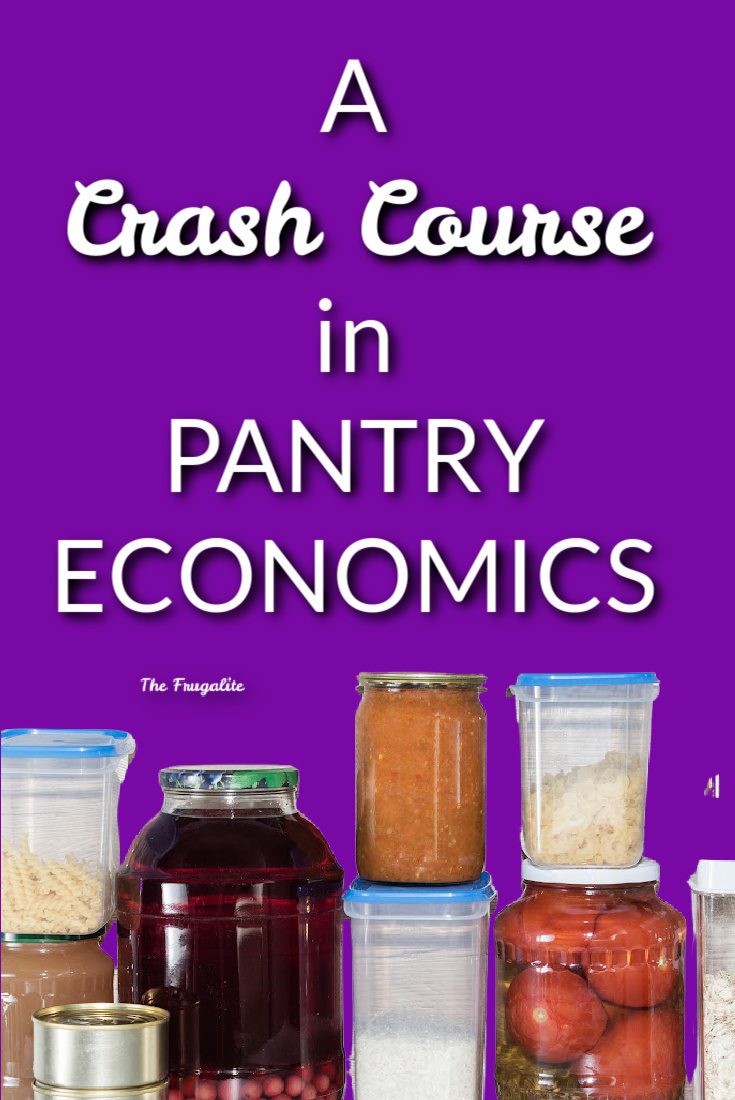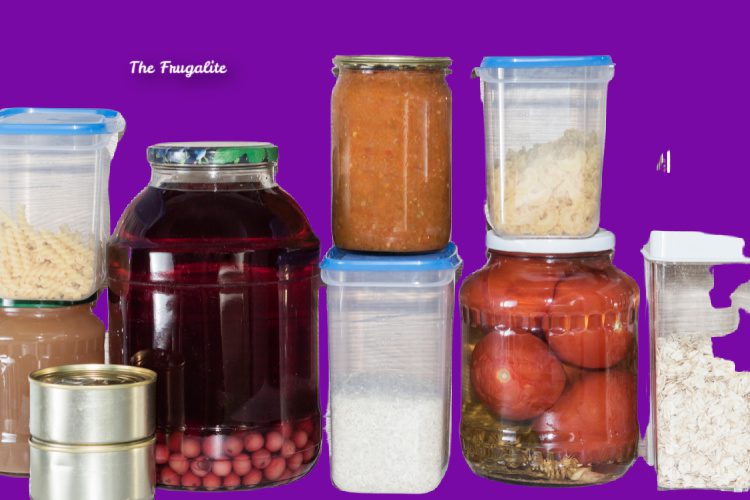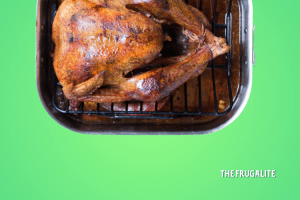(Psst: The FTC wants me to remind you that this website contains affiliate links. That means if you make a purchase from a link you click on, I might receive a small commission. This does not increase the price you’ll pay for that item nor does it decrease the awesomeness of the item. ~ Daisy)
I wasn’t always interested in pantry economics. It was reading Joel Salatim’s books and Ben Faulk’s The Resilient Farm and Homestead that opened my eyes to the world of how much money one can save by keeping stored food at hand. Faulk mentions within his book that keeping a properly stocked larder can actually save you money due to ever-increasing food costs due to inflation.
And his observations ring true. If we look at the cost of food from 1913 to 2021, we see that the average price of inflation is 3.12% per year. While the US Department of Labor states that food prices have risen 3.7% within the past 12 months , reality seems to be exponentially higher, with some reports stating that 40% is a much more realistic number.
Here’s a crash course in pantry economics that will show you the value of putting back some food.
Let’s assume we take the US Dep’t of Labor at face value, however
If such were truly the case, and inflation only rose 3.12% last year, that would mean if you’d bought $100 worth of canned food back in 2019, it would be worth $103.12 today, right? Perhaps $3 isn’t that exciting to you though.
If you say that you had spent $100 on canned food five years ago though it would mean you’d have $116.86 worth of food today. Again, however, this is assuming that the US Dep’t of Labor is telling the truth on those figures. If we look back at January 2017, we find that corn was selling for $358.00 per bushel. As of this writing (2021), corn is currently selling for $526.75. [source]
Does that sound like 3.12% inflation per year to you? If we look at wheat, we find that in January 2017 it was selling for $423.25 per bushel. As of this writing, wheat is selling for $720.50 per bushel. Again, is that 3.12% inflation? If we look at oats, we find that in January 2017 $223.30 per bushel was a standard price. Currently, oats are selling for $586.00 per bushel. [source]
Pantry economics is a winning hedge against inflation.
You probably get the point by now I’m trying to drive home
Inflation is much more than 3.12% per year when it comes to food, and if anything, it seems as if trends are accelerating for even further inflation at the moment when it comes to food prices. Remember that 40% inflation over the past year statistic we looked at earlier? That sounds much more reasonable than the “official” 3.12% now, does it not?
Even if we assume that things were to level off from 40% to 10% inflation per year for food by 2022 (and looking at current economic trends, this is a pipe dream of a number), you still stand to get a 10% return on your investment by putting money into canned food and other storable food items now.
Where else do you know of that you can get 10% return on investment the next year? Can you think of anyplace more tangible to see your money increase than with food? Sure, you could always put that $100 into a mutual fund, individual stocks, annuities, bonds, or what have you, but if we consider the economic trends of the past 100+ years (1913-2021), you stand a very good chance to actually save yourself money down the road by investing in stored food today.
Pantry economics: a fully stocked larder can save you heartache in the future
At the moment, grocers around the world are having a difficult time keeping their shelves stocked. Everybody is well familiar with the toilet paper shortage of early 2020. It seems as if there’s an everything shortage for 2021.
Within the UK, stated shortages of truck drivers are keeping grocery store shelves empty. [source] Within the US, we’re seeing staffing shortages being a large cause of massive food shortages. [source]
Food security matters
In such an event, a fully stocked larder not only means an economic means of ensuring that your family has food to eat in future years, but it also proves to be a drastic layer of food security.
Whether grocery stores go barren, you lose a job and are unable to bring in a paycheck for some time, or something else happens that makes it so that you aren’t able to get ready access to fresh food from your local grocer, practicing pantry economics in the form of a fully stocked larder can help to serve as a form of economic mitigation against financial duress.
Many people condone storing up an emergency fund to get one through brief periods of financial troubles (e.g. Dave Ramsey’s 3-months’ earnings fund), but why don’t we as a culture consider the same with food? Not only does it save one money in the long run, but it is an economical way to prepare for the unforeseen events of life as well.
What do you think about pantry economics?
What are your thoughts on pantry economics? Are there other components here you think we should have covered? Has this article got you to consider storing food? Let us know in the comments below!
*Disclaimer: I am not a financial advisor, nor do I pretend to be. None of the above is financial advice. If you are seeking professional financial advice, seek out a licensed financial advisor.
To Learn More About Building a Pantry:
- Online Course: Build a Better Pantry on a Budget (currently this course has “name your price” pricing)
- Book: Prepper’s Pantry (you don’t have to be a prepper to get a lot out of this book by Daisy)












24 thoughts on “A Crash Course in Pantry Economics”
The one thing I learned from my grandparents (Depression survivors) was the importance of a well stocked pantry. Thru thick and thin, it is the one thing I have never skimped on. I never thought of it as an inflationary hedge. Before I got into ‘prepping’, I usually had at least several weeks built up. The one thing my kids always knew they would never go hungry. It wasn’t gourmet or what they might have wantedbut their bellies were always full. (And they learned how to frugally stock their own pantries.) Nowadays, I obviously look at things a little differently, and my larder is ‘stacked’ in ‘layers’. But this is the one area I still will not skimp on.
i wonder about you numbers for grains. for example, a bushel of wheat weighs 60 pounds. if the going price for a bushel is $720, that would make it $12 per pound. but it’s not. no one would be eating bread at that price. i can buy organic hard red wheat from azure standard for $.91 per pound in a 5 pound bag. maybe you were thinking of the price per ton?
I agree, Grammy Em. Those numbers are WAY off!
we pay more like$2.00 lb for organic. 100% more…
Ahh, sorry ya’ll. I gave ya’ll the wrong units.
If one clicks through the source link it’s made apparent, but I didn’t specify within the article here. I use the price of futures (e.g. oat futures) to show food pricing here. With one oat future, those prices are accurate. Prices of any commodity have drastically risen of late, but, yes, the catch is that a single oat future is 5000 bushels of oats.
So the dollar amounts are spot on – and unless I’m missing something, no, the math isn’t laughable – it’s just that I gave ya’ll the wrong units.
Sorry about that ya’ll.
This is a good idea/article in that it presents the idea of a stocked pantry from a position of common sense and budget control rather than the common prepper viewpoint that the sky is going to fall any minute. I appreciate both sides of the argument, but I think we will have a lot more luck as influencers if we choose the former.
My hope is that a well-stocked pantry eventually becomes normal for as many people as possible. If you are able to, can foods from your garden or from the market in-season. If not, stock your from the market when items are on sale. You will always be buying at a lower price and you will always have something to eat. Just a couple cans a week will add up over time.
Love this s article, its SOOO important. My budget and pantry are always what gets me through. With kids with dietary issues. We shop certain brands to get consistency. But here our prices have increased alot more than your article. At first I thought it was due to moving to a rural area. But I staple my receipts to my shopping list for budget reasons and going back to 2019 buying all the same items from the same store my cart had gone up $72.13!! And four items have reduced their size but the same price therefore becoming more expensive too. I don’t think I’ll ever see 2019 prices again. But need to make the most of cooking from scratch & hoping for a plentiful summer garden more than ever. I’ll look into the book you mentioned. Anything that I can glean is always super appreciated.
Your prices on grains is waaaaay off. I know you mean well but your math is laughable.
Keeping one’s pantry well stocked and then some is so important.
Living on a limited income I still add to my pantry monthly. Along with my gardening, canning and cooking most everything from scratch with foods in my pantry, helps today but is insurance for times to come. I definitely want to invest in purchasing the online course and Daisy’s book. No matter how much we think we know we can always learn so much from others.
Thanks for sharing.
The increasing shortages make me really glad I have a bunch of the basics stocked up. One challenge a lot of folks run into is quantity limits, so it can be hard to take advantage of good sales. One partial solution for this is to make a couple trips during those sales. Buying just a little extra every time also helps you build up a reserve. Mostly through doing that I could probably live for six months on the food in my pantry if I had to. Maybe longer. The “buy a little extra every time and do it consistently” method really helps you avoid people’s notice as well.
Avoid people’s notice? Ha! ?
For years i’ve been hitting Dollar General’s 2 for $1 on vegetables. I’ll load up 50 cans in the cart, i don’t care WHO notices… They can make all the faces they want when their children are going hungry and mine are not….
And the funny part? I rarely even EAT vegetables!! I despise em! Lol The wife and kids eat em. They also make great barter items worth WAY MORE than you paid, and i can also give them away to friends and family i care about. And stored properly, they will keep way past their expiration date.
I learned a long time ago prepping for hurricanes in south Florida…. When emergency is declared, it’s like the gun going off at a race…. It’s EVERY MAN AND WOMAN FOR HIMSELF! It’s a shame, but it’s reality now. Seen the fistfights at the gas pumps, the propane lines, the lumber lines…. there were even armed scumbags waiting at stop signs and red lights near Targets, Publix, Walmart, Costco etc. When people stopped at the stop signs, they would rob them of their purchases at gunpoint.
Society loses their mind during mass emergencies. And it still blows my mind HOW MANY PEOPLE STILL REFUSE TO PLAN AHEAD!!! Even experienced storm veterans!
Not us… Any HINT of a bad situation, i immediately rush out and top off supplies before the lazy unmotivated masses turn the retail world into lord of the flies. We’re all home safe and snug watching the zombies collide on the news LONG BEFORE the crazy starts.
The above article? Only reinforces the practice that prepping is simply WISE…
Spot on! My mom was a “Prepper” before the word was coined. We had a full pantry in a small room in our basement. When we’d have a huge blizzard, we lacked for nothing. It’s how you show love for your family??
The spot price for Oats today was $5.91 per bushel in Iowa. Your grain prices are way off. But we personally have followed the pantry principle for the 55 years of our marriage…we have no debt.
It’s not just food, but all staples, basics, even your gas for the car. KEEP IT FULL…I filled up last Wed. I paid $2.98 for reg. unleaded. Today jut 7 days later it’s $3.09…Ahhhhh, that’s 11cents more per gallon for the same gas at the same station in 1 week…How much more will it cost me next week or the week after that…Will it go up to $4.00 or more this month…well as fast as food is climbing, it would not surprise me…Always buy at today’s prices b/c tomorrow you may well pay more…Buy all the basics, from paper towels to Kleenex to cleaning supplies, laundry detergent ALL of it… It’s certainly NOT getting any less expensive…
I wholeheartedly agree re: not just food. Matter of fact, I just replenished stock of what I deem non-edibles. Still have a bit more to replenish of a few items (keep a year’s supply). Not only gas but blades for tools, oil, home repair supplies, pet/livestock feed etc. Also replacing appliances, HVAC, etc. on a regular basis (lifespan of item) is not a bad idea but requires budgeting. Necessity makes a poor bargain.
Your local gas prices sound wonderful. Here in northern California, our cheapest local gas is $4.35. This is a rural town on the western slope of the Sierra. However, an hour away, where our son’s family live (a farming town in the Sacramento Valley), their cheap gas is consistently 30 cents per gallon cheaper! In the urban areas like San Francisco and the surrounding Bay Area, gasoline has reached $5/gallon. The farming towns of the Central Valley (north and south of Sacramento) are poorer, and the gas stations don’t dare charge like they do in the urban areas. Believe it or not, there are plenty of conservatives in California, mostly rural until the urbanites flee the cities and infect us with their … sorry, I’m ranting and I’ll stop now. I have built short and long term pantries, and juggle using bargains from my freezer and home-canned meals.
I read fooddive.com every day. It relates what companies are bringing out new products, etc. But I read it for the financial news – today had an article about PepsiCo raising prices on it’s products first quarter of 2022. A couple of months ago an article about prices being raised on paper goods like diapers, feminine protection products, paper towels, etc. Also articles on the difficulty with getting aluminum for cans, glass containers, and now the cardboard for salt! All this means higher prices. With this information I’ve been able to add to my supplies at current prices. Every little bit of information on increasing prices helps.
Thanks for info on that website, Bellen. Good info.
I just read an article on Reuters that was linked from fooddive.com. It says: On “the most globally traded food commodities…On a year-on-year basis, prices were up 32.8% in September.
Agricultural commodity prices have risen steeply in the past year, fuelled by harvest setbacks and Chinese demand.”
https://www.reuters.com/business/world-food-prices-hit-10-year-peak-fao-2021-10-07/
As of today (October 7th, 2021), the price of a bushel of corn is $5.34 a bushel ($210.25 per ton). It was over $7.50 a bushel back in May, but prices have come down with the harvest. Wheat is $269.50 per ton ($7.34 per bushel). A bushel of oats is $6.23 (or $389.38 a ton).
I don’t disagree with what you’re saying in the big picture, and yes grain prices are rising, but your data is overstated by leaps and bounds.
Whether or not you agree with the degree of price inflation, having food stored just makes sense. If something is short one week, you can either pay the high price, buy a different item OR use what you’ve stored and just wait for it to be restocked. You don’t have to change your menu, budget or drive all over trying to find what you need.
We don’t have much storage space so we have a short list of extra staples to create a breakfast, lunch and dinner (right now ours is instant oatmeal, Crystal Lite orange drink with vitamin C, all kinds of yummy canned soup, packets of tuna salad and chicken salad, and wheat crackers). If you have pets, add a few cans of a food they like and just rotate them into their diet as a special treat.
If you can only afford to stock up enough for a week or so, wait for a good sale on soup and crackers, and whatever hot cereal you like. Now you don’t have to rush out when you hear a storm is coming or there’s some other disaster in the offing. Pretty soon you’ll find it’s so convenient to always have a quick go-to meal that you automatically buy a few more of your favorites whenever you see them on sale.
You don’t need lots of storage space or a dedicated pantry to do this limited stock-up. If there’s room in some room of your house for a sturdy three or four shelf plastic unit like those that go on sale at Home Depot or Target, you can put a pretty king-size sheet you get on clearance or at the thrift store up as a curtain and fill your new pantry with just a few things you KNOW you’ll use up and just naturally rotate. Put the newest cans or boxes in behind everything else. If you really get into this, you can make or for about $20 buy a 36-can organizer where you can set cans in at the back and they roll to the front so you’re rotating them by date automatically. You can see at a glance what essentials are getting low or what you have more room for.
It feels so good to know there’s always a meal at home, even if it’s a bowl of oatmeal with raisins and some orange drink, or vegetable soup and crackers. If you’re living in a small apartment or other small space, this limited plan works to keep you comfortably fed no matter what.
The one thing that I noticed that nobody including the article has mentioned yet is good pantries. For those of us that are on a fixed income due to what ever reason. There are food pantries all over. The one near me is ran by care and share. And is based on the number of people living in your household not how much money you make. We have tripled our pantry without spending more money. They have a large variety of canned goods along with dry goods such as pastas, Rice, Oats and Beans. The canned goods range from soups to chili and vegetables. Then there are the fresh and frozen items that varies from week to week. And yes there are quantity limits for some of the high demand items. This is free food people it might not be brand name but it will keep you alive. Enough of my droning on. Be safe, Be Vigilant, keep your head on a swivel.
I worked in a food bank for a little while, and one thing of note is that people don’t want staples, they want instant food. We had literally bags of plain oatmeal, beans, rice, and other staples just sitting. People who came from impoverished countries would come in and want the beans, and I’d say “You bring a dolly?” because we had so much just sitting. If you make the rounds of a few pantries when in real need (try the ones at schools and churches) you may find they have good long term storage items just begging to be taken home by someone who will actually make use of them. I loved it when one family, in particular, came in and saw the beans and not only took what we had, but the head of the household came back with recipes “so people will know this is good food.” They couldn’t believe that someone would just give them enough food to get by for a month. One of the best food bank moments ever.
That’s really sad to hear, but it warms my heart that that family was able to benefit.
My sister and I grew up on a bare subsistence farm We survived on a garden, eggs, home canned food, and lots of beans and rice. When there was a little extra money, my mother stocked up on non perishables-the beans, rice, oatmeal, flour. Years later my sister and her family lived in a small town with one private bank. The bank suddenly failed. It was several months before people got about 50% of the money they had deposited. During that time her family’s business suffered, leaving them with limited income. Due to her experience from childhood she had a very well stocked pantry. They got through the rough times without food problems even though the only purchases were a few perishables. By the time they were back to a more normal income the pantry was seriously depleted. With renewed income the pantry was gradually restocked. I haven’t had a drastic loss of income, but I keep a full pantry.Both of us have kids who have the same idea. Nothing like setting an example.